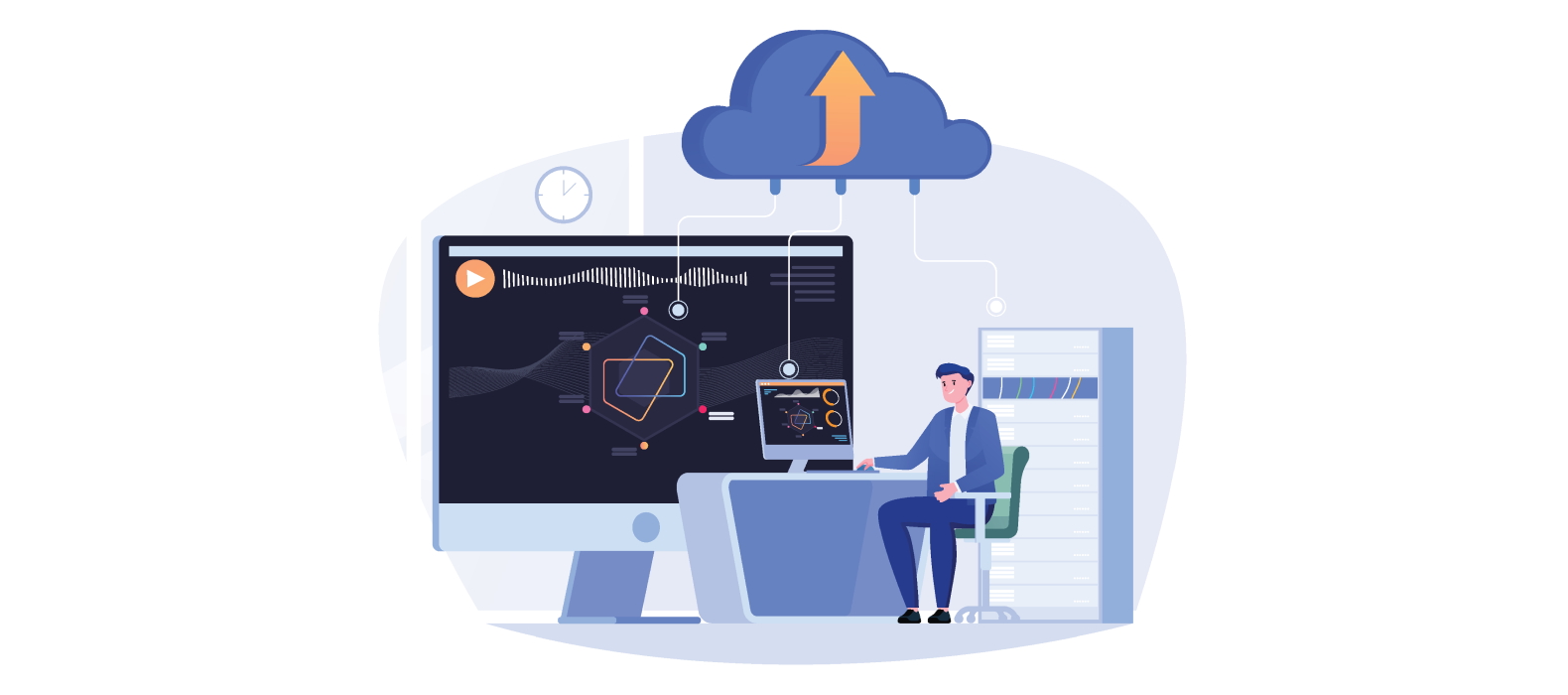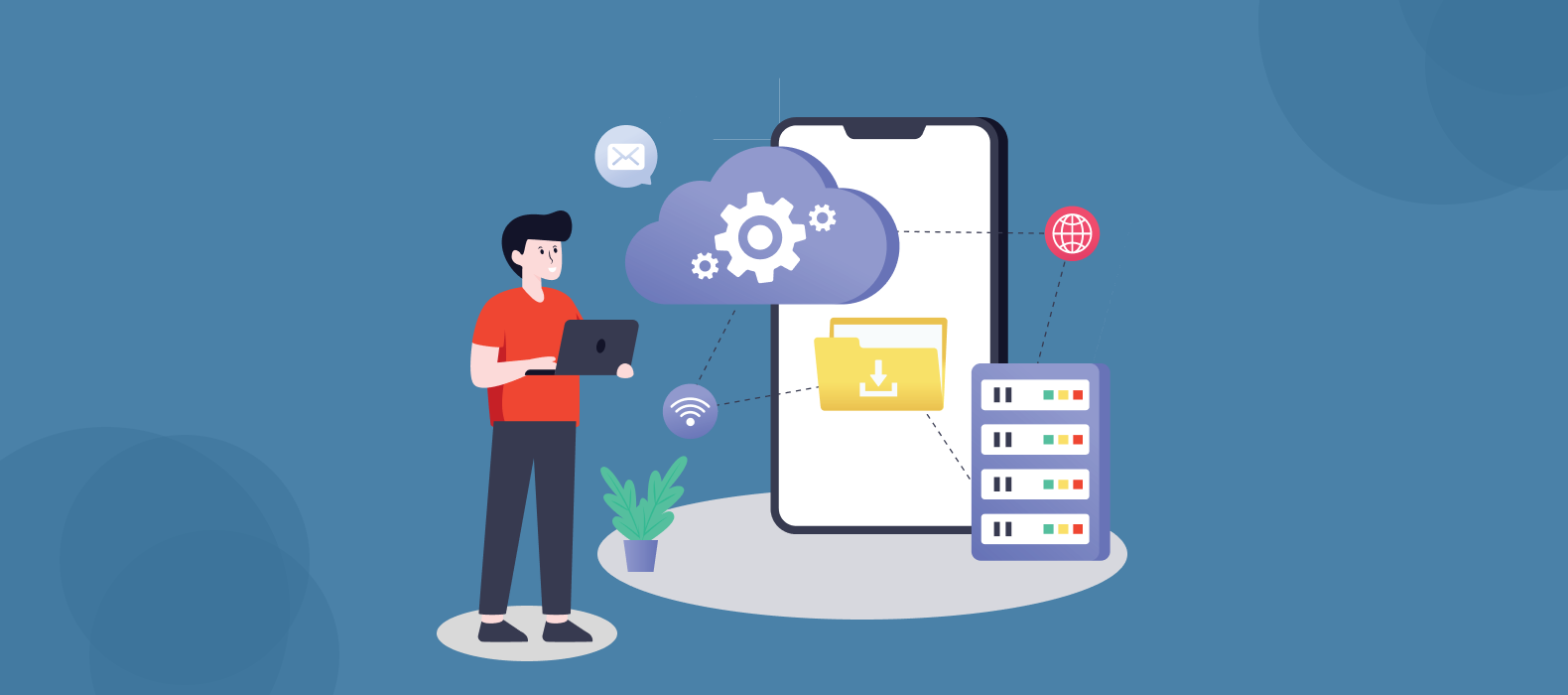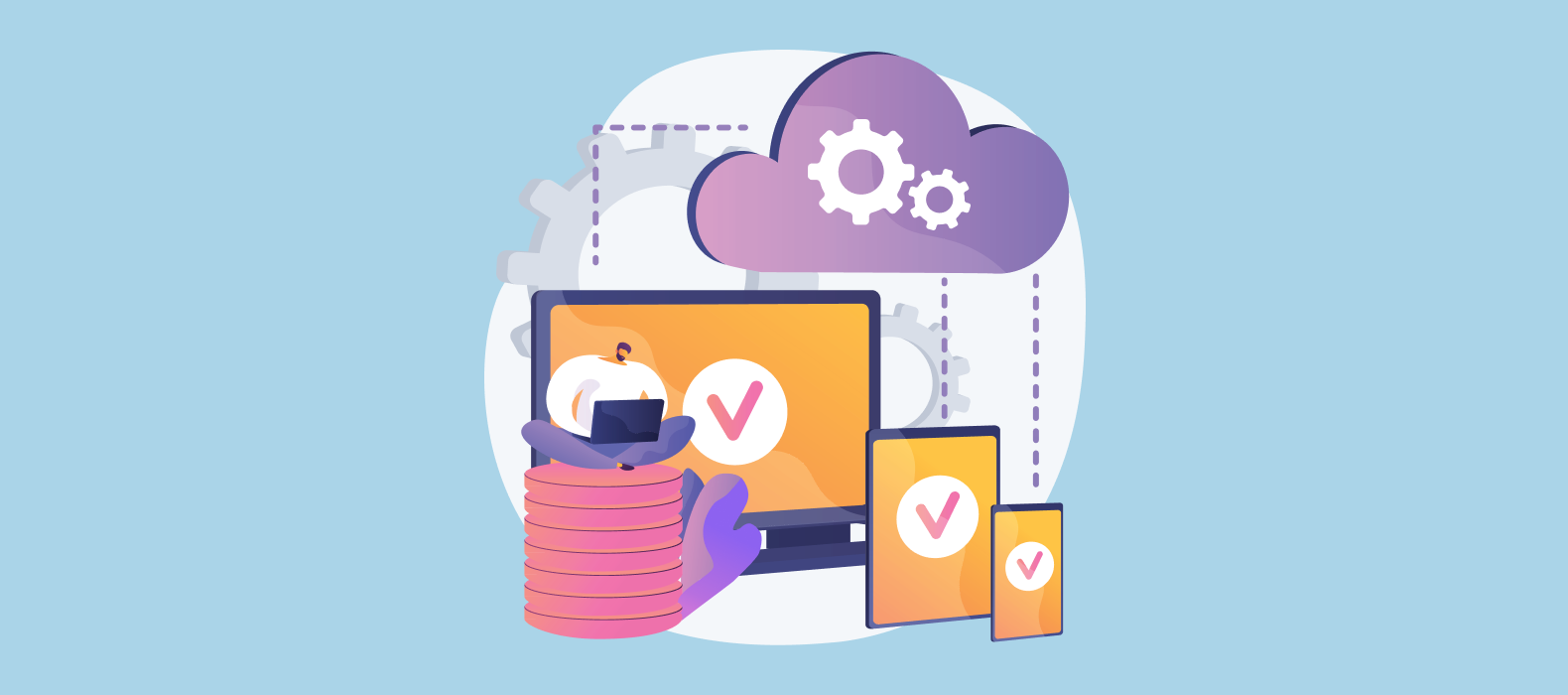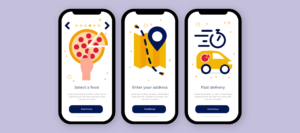If you’ve lived in the tech world for a long time, you should know how frequently “the cloud” is mentioned. That was an IT buzzword around a decade ago. Now? Cloud software development is the next phase in the evolution of corporate software, and the statistics indicate that.
89% of businesses now employ a multi-cloud strategy, with 80% relying on a hybrid model that combines private and public clouds.
But here’s where things start to get interesting. 57% of these businesses are moving more workloads to the cloud.
According to a Globenewswire analysis, the market for the ecosystem of cloud computing apps will rise at a CAGR of 35.8% to reach $56.18 billion in 2026.
Cloud-based application development solutions make data collection easier for businesses. Moreover, security and management streamline. Modern companies and enterprises can construct productivity-based applications to improve customer experience and income through cloud app development. Additionally, Cloud software development solutions enable companies to spend money on low-code app development, which is once more a time- and money-saving approach.
If you’re a business owner or marketing manager and decide to move your apps onto the cloud, you must carefully consider how your startup will grow. What are your most effective tactics? What are the benefits?
In this blog, we’ll examine why cloud-based apps are so important and how you can design your app.
What is Cloud Application Development?

Cloud Application Development is creating and deploying software applications for cloud computing platforms. Cloud computing refers to using remote servers, accessed via the internet, to store, manage, and process data. Cloud application development involves creating software applications that can take advantage of the scalability, flexibility, and cost-effectiveness of cloud computing.
The development typically involves using cloud-native technologies and architectures, such as microservices, serverless computing, and containers. These technologies enable developers to build applications that can quickly scale up or down as needed without worrying about the underlying infrastructure. Cloud application development typically involves using cloud-based tools and platforms, such as Amazon Web Services (AWS), Microsoft Azure, and Google Cloud Platform.
Benefits of Cloud App Development for Your Business

Here are ten benefits of cloud app development for your business:
1. Scalability:
Scalability is one of the key benefits of cloud app development for businesses. With cloud technology, companies can quickly scale their applications up or down to meet changing demands without investing in expensive hardware or infrastructure. This can be particularly useful for businesses that experience spikes in traffic or have fluctuating resource requirements.
Cloud-based application development allows for simple scalability. While the traditional model necessitates extensive planning, such as the hardware your app will run on, servers, and so on, cloud-based apps make it simple to scale any part of your application because you don’t have to worry about hardware.
For instance, By adding additional servers, you can scale your server.
2. Cost savings:
One of the primary benefits of cloud applications is their low cost. It significantly reduces setup and maintenance costs because no on-site infrastructure or servers are required. The cloud provider manages all hardware.
In essence, cloud services let you pay only for your infrastructure and resources, leaving the rest up to the cloud provider. In addition, the service is charged when it is active, so ceasing use will result in no further costs.
3. Increased agility:
Cloud app development offers several benefits to businesses, one of which is increased agility. This enables enterprises to rapidly deploy and iterate applications, allowing them to respond more quickly to changing market conditions and customer needs. Here are some ways in which increased agility can benefit your business:
Faster time to market: Cloud app development enables developers to create and deploy applications more quickly. This means your business can launch new products and services faster than your competitors, giving you an edge in the marketplace.
More flexibility: Cloud app development allows for more significant scaling up or down flexibility, depending on your business needs. This means that you can quickly respond to changes in demand and adjust your resources accordingly.
4. Accessibility:
Cloud app development can significantly benefit businesses regarding accessibility, as it allows for easy access to applications and data from any location, at any time, and on any device with an internet connection. Here are some of how accessibility can enhance through cloud app development:
Remote access: Cloud app development enables employees to access applications and data from anywhere, as long as they have an internet connection. This means that employees can work remotely, from home, or while traveling, without being limited by physical office space or location.
Device independence: Cloud applications can be accessed from any device, whether a desktop computer, laptop, tablet, or smartphone. This means that employees can choose the most convenient device without being limited by the availability of a particular device.
5. Improved collaboration:
Improved collaboration is one of the significant benefits of cloud app development because it enables developers, project managers, and stakeholders to work together more effectively and efficiently. With cloud app development, all team members can access the application and the development environment from anywhere and at any time, as long as they have an internet connection.
Cloud app development provides a collaborative platform allowing team members to work on the same codebase, view, and edit files simultaneously, and share real-time feedback and ideas. This level of collaboration enhances the speed and quality of development, reduces the time taken to resolve issues and errors, and minimizes the need for communication between team members.
6. Disaster recovery:
Disaster recovery is recovering data, software, and systems after a natural or artificial disaster. In cloud app development, disaster recovery is a benefit because it allows developers to recover data and systems during a disaster quickly.
With cloud app development, data is stored in the cloud, meaning it is not tied to any specific physical location. This makes it easier to recover data and systems during a disaster. Cloud providers typically offer disaster recovery services that allow developers to quickly recover data and procedures, which helps minimize downtime and reduce the risk of data loss.
7. Security:
The cloud is one of the most secure methods of storing data. Data security has been a problem for businesses for years, and protecting sensitive data is becoming increasingly difficult.
With cloud services, you have access to various security measures that can help keep your data safe.
For instance, some services have file-level encryption, while others include encryption in their software. As a result, even if someone gains unauthorized access to your account or computer, your data remains secure.
8. Integration:
Integration refers to the ability of different software applications to communicate and exchange data. In the context of cloud app development, integration can refer to the ability of a cloud-based application to seamlessly connect and work with other applications or services that are also hosted in the cloud.
One of the main benefits of cloud app development is the ease with which different applications can integrate. Cloud platforms often provide a range of pre-built integration options that make it easy for developers to connect their applications to other cloud-based services, such as storage, messaging, and analytics tools.
9. Improved performance:
Improved performance is one of the key benefits of cloud app development. Cloud app development allows developers to build and deploy applications in a highly scalable and distributed environment. This means that cloud-based applications can handle large amounts of traffic and data without experiencing performance issues or downtime.
One of the main reasons for improved performance in cloud app development is the use of cloud infrastructure. Cloud infrastructure provides developers access to powerful computing resources and storage capacity, which can be scaled up or down as needed. This allows developers to build applications that can handle many users and data without compromising performance.
10. Innovation:
Innovation is a critical benefit of cloud app development because it allows developers to quickly create, test, and deploy new applications without significant upfront investment in hardware or infrastructure. Cloud app development also provides developers with various tools and services that enable them to rapidly prototype, iterate, and improve their applications.
Overall, by providing access to powerful development tools and services, enabling rapid iteration and experimentation, and allowing developers to leverage the latest technologies and frameworks, cloud app development provides an environment that encourages innovation and creativity, ultimately creating more advanced and sophisticated applications.
How to Develop a Cloud Application?

Developing a cloud application involves the following steps:
- Define the Requirements: The first step in developing a cloud application is to define the requirements. This involves identifying the goals of the application, the features it should include, and any constraints that must be considered.
- Choose the Cloud Platform: Once the requirements have been defined, the next step is to choose the cloud platform. This involves selecting a cloud provider, such as AWS, Microsoft Azure, or Google Cloud Platform, and deciding which services to use.
- Design the Application Architecture: The next step is to design the application architecture. This involves identifying the application’s components, such as databases, servers, and APIs, and how they will interact.
- Develop the Application: With the application architecture in place, the next step is to develop the application. This involves writing code, integrating with cloud services, and testing the application.
- Test the Application: Once the application has been developed, it must be tested to ensure it meets the requirements and functions correctly. This involves testing both the functionality and the performance of the application.
- Deploy the Application: Once the application has been tested, it can be deployed to the cloud. This involves configuring the application to run on the cloud platform and ensuring it is secure and scalable.
- Monitor and Maintain the Application: After the application has been deployed, it must be monitored and maintained to ensure it continues functioning correctly. This involves monitoring performance, managing resources, and making necessary updates and improvements.
Overall, developing a cloud application involves software development, cloud infrastructure, and system administration skills and requires careful planning and execution to ensure that the application meets the requirements and performs as expected.
Challenges while Developing Cloud Application

Developing a cloud application can present several challenges. Some of the common challenges include:
- Security: Security is a significant concern when developing cloud applications. Cloud applications are vulnerable to attacks, such as data breaches, denial-of-service attacks, and injection attacks. Developers must implement robust security measures to protect the application and the data stored on the cloud platform.
- Scalability: Cloud applications must be designed to scale horizontally and vertically. This requires careful planning and consideration of resource allocation, load balancing, and auto-scaling factors.
- Complexity: Developing a cloud application can be complex, as it involves integrating multiple technologies and services. Developers must have a good understanding of cloud architecture, microservices, containerization, and other cloud technologies.
- Vendor Lock-In: Using a specific cloud provider can lead to vendor lock-in, making it difficult to switch to another provider in the future. Developers must carefully evaluate the pros and cons of each cloud platform and choose one that meets their current and future needs.
- Integration with Legacy Systems: Integrating cloud applications with legacy systems can be challenging, as it requires bridging the gap between new and old technologies. Developers must ensure that the application can communicate with other systems in the organization and that data can be transferred securely.
- Cost: Cloud platforms offer a pay-as-you-go model, but costs can quickly increase if the application is not optimized for cost efficiency. Developers must ensure that the application uses resources efficiently and minimizes costs.
- Performance: Cloud applications must be designed to perform well, even under heavy loads. This requires careful optimization of resources, such as CPU, memory, and network bandwidth.
In summary, developing a cloud application can be challenging, but with careful planning and execution, developers can overcome these challenges and create high-performing, secure, and scalable cloud applications.
How Much Does it Cost to Develop a Cloud app?
The following factors affect how much it will cost to develop a cloud software platform or application:
- Product development
- Specifications of the product
- The location and cost of your outsourced development team
- Size and complexity of the project
- Stack of technologies
- Timeframe
The cost of developing a cloud app can range from $25,000 to $50,000, depending on the complexity of the application and the factors listed above. Working with an experienced development team is essential to ensure the app is developed within budget and to a high-quality standard. For a rough estimate of cloud app development costs:
| Application Type | Development Time | Cost |
| Basic Cloud Application | 200 to 600 hours | $15,000 – $30,000 |
| Medium to Complex Cloud Application | 800+ hours | $25,000 to $50,000 |
The cost of cloud hosting is separate from the range mentioned above. You can use any hosting platform, such as AWS, Microsoft Azure, or Google Cloud.
Considering all factors, your cloud development service provider can provide an accurate cloud app development cost estimate.
Conclusion
Cloud application development has taken over the app market and shows no signs of slowing down anytime soon.
Companies are now faced with migrating their entire infrastructure to the cloud. Most businesses will eventually have a platform that integrates hundreds of cloud technologies. The best course of action is collaborating with an IT consulting company to create a complete cloud infrastructure based on a reputable and well-known platform like Microsoft Azure. Outsourcing to a software application development company can be the most cost-effective solution because your employees can learn the intricacies of Azure without having to learn the intricacies of Azure.
FAQs
Question 1: What is cloud app development?
Cloud app development is the process of building and deploying software applications that run on cloud computing infrastructure rather than on local servers or devices. This allows for greater scalability, flexibility, and accessibility of the applications.
Question 2: What are the benefits of cloud app development for businesses?
Some benefits of cloud app development for businesses include lower costs, greater scalability, improved collaboration, increased accessibility, and enhanced security. Cloud-based applications can also be easily updated, maintained, and accessed from anywhere with an internet connection.
Question 3: How can cloud app development improve collaboration within a business?
Multiple users can access Cloud-based applications from anywhere, allowing for greater collaboration and communication between team members. Cloud-based productivity tools such as project management software, document-sharing tools, and messaging apps can all be accessed from any device with an internet connection, making it easier for team members to work together on projects.
Question 4: How does cloud app development improve accessibility for businesses?
Cloud-based applications can be accessed from anywhere with an internet connection, making them much more accessible than traditional software applications. This allows employees to work remotely or from different locations and allows for greater flexibility in the devices that can be used to access the applications.
Question 5: What security concerns should businesses be aware of when using cloud-based applications?
Businesses should be aware of potential security risks associated with using cloud-based applications, including data breaches, unauthorized access, and data loss. It is essential to choose a reputable cloud service provider with robust security protocols and to implement appropriate security measures, such as strong passwords and two-factor authentication.
Question 6: How can businesses ensure that their cloud-based applications are compliant with industry regulations?
Businesses should work with their cloud service provider to ensure their applications comply with relevant industry regulations, such as HIPAA for healthcare data or GDPR for personal data. This may involve implementing specific security measures or data handling protocols and require regular audits to ensure compliance.




